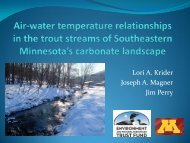Minnesota Water Resources Conference - Water Resources Center ...
Minnesota Water Resources Conference - Water Resources Center ...
Minnesota Water Resources Conference - Water Resources Center ...
You also want an ePaper? Increase the reach of your titles
YUMPU automatically turns print PDFs into web optimized ePapers that Google loves.
BOOK OF ABSTRACTS<br />
Tuesday, October 28<br />
Concurrent Sessions VI 3:00–4:30<br />
Track D: Flood Reduction and Riverine Habitat, continued<br />
Home on the Big River: Great River Habitat Quality Indices<br />
Debra Taylor, U.S. Environmental Protection Agency, taylor.debra@epa.gov; Mark Pearson, U.S. Environmental Protection<br />
Agency; Theodore Angradi, U.S. Environmental Protection Agency; David Bolgrien, U.S. Environmental Protection Agency;<br />
Brian Hill, U.S. Environmental Protection Agency; Terri Jicha, U.S. Environmental Protection Agency; and Mary Moffett, U.S.<br />
Environmental Protection Agency<br />
The U.S. EPA’s Environmental Monitoring and Assessment Program sampled the Upper Mississippi, Missouri<br />
and Ohio Rivers from 2004 through 2006 as part of an integrated assessment of ecological condition. We<br />
developed site-scale fish habitat indices by dividing the components of habitat into four categories: Channel<br />
complexity, substrate, littoral structures, and human impacts. Once site-scale indices were established,<br />
we evaluated if landscape-scale land use and cover metrics could improve the site-scale indices. On the<br />
Impounded reaches of the Mississippi, channel complexity, substrate, and landscape-scale measures of forest,<br />
shrub, and grass cover explained 49 percent of the variation in the fish community. On the Lower Missouri<br />
and the unimpounded reaches the Mississippi downriver from the Mississippi/Missouri confluence, the fish<br />
community was related to channel complexity, substrate, and the proportions of shrub land cover, grassland,<br />
and pasture. Fish communities on the Ohio River were correlated with distance to nearest upriver dam,<br />
substrate, and the proportions of land cover in shrubs and grasslands.<br />
83 <strong>Minnesota</strong> <strong>Water</strong> <strong>Resources</strong> <strong>Conference</strong>, October 27–28, 2008
















